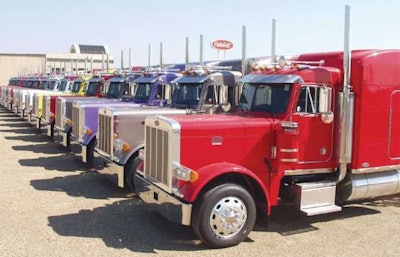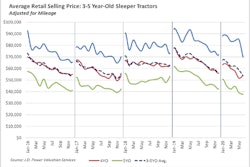The following is Part 2 of a 12-part special report from Trucks, Parts, Service on the state of the used truck market.
 .
.Determining the trade-in value of a used truck is a tricky proposition. Dealers do their best to incorporate exacting assessment procedures into what many consider an inexact science.
Further complicating the issue are market supply and demand dynamics that turn the inexact science into more of an art form. With new truck deliveries hitting all-time highs in 2019 and 60 to 70 percent of sales involving trade-ins, thousands upon thousands of trucks have entered the secondary market in the last year.
Within the market, evaluation of a used truck’s value should begin the instant a dealer is presented with an acquisition opportunity. Lacking a perfect way to assess condition, and without a sure formula to determine how much condition, specifications and age should determine price, dealers are forced to weigh each factor independently and set a potential price on their own.
KEA Advisors’ John Whitnell says most dealers are good at determining value for trucks that share their nameplate. For other brands, it helps for dealers to have a network of contacts across the market “they can trust and that have a pretty good understanding of value that they can lean on,” Whitnell says.
Learn how to move your used trucks faster
With unsold used inventory depreciating at a rate of more than 2% monthly, efficient inventory turnover is a must for dealers. Download this eBook, “Sold! Best Practices for Moving Used Trucks,” to access proven strategies for selling used trucks faster.
In cases where dealers have access to potential trade-in units, that accessibility shouldn’t be squandered. Taking time to send an associate out to do an appraisal or even visual inspection of trade-in equipment can stop a dealer from entering into a potentially disastrous deal. Even in cases where the trade-in appears to be in good shape, dealers must be sure to identify any unique specifications or features that could have an impact on resale values down the line.
And used truck managers shouldn’t be afraid to speak up when concerns arise. Whitnell advises used truck managers provide their assessment and valuation results to the new truck salesperson, dealer principal and fleet, ensuring each party is aware of the parameters needed for the dealer to profit on the transaction.
“If you [as a used truck manager] can go to your boss and say, ‘Here are 14 trucks like the ones in this deal, here’s what they were sold for and here’s what we need to get for them to make this deal,’ that’s really valuable information,” Whitnell says. “It might not stop the deal, but at least everyone knows the situation and what needs to be done.”
This is especially true when a used truck department is taking on inventory in an already saturated market. Used truck values fluctuate with industry factors and everyone involved in a trade situation should be aware of that.
“We try to give a very fair number because we still want to do as much as we can as far as deals go, but the customer has to be willing to be realistic in the trade price if the market is down,” says Justin Candea, sales director, Young Truck Sales.
Dealers also should be upfront with customers in cases where a trade-in agreement is being discussed months before a dealer will actually take ownership of used equipment. Dealers must consider depreciation, as well as wear and tear during the period between the negotiation and the transaction being finalized.
Rush Truck Center dealerships are instructed to consider specs, the time of actual delivery of a traded truck as well as mileage, condition and other factors, says Trey Golden, vice president, used truck sales.
Experts also stress the importance of re-inspecting the truck when finally taking delivery. Once trade-in units arrive at Young Truck Sales, Candea says his team looks at overall condition of the units and runs computer diagnostics to check codes and determine when the last regen was run, “because a lot of the issues we run into are aftertreatment related,” he says.
Issues that drive down the acquisition price and resale value of a unit should then be addressed immediately with the fleet. Dealers should not be expected to take a blanket loss on a truck that does not meet parameters agreed to in a trade agreement.
“You can work through a mistake on one truck, but if you make a mistake on a 500-truck package … that’s where people really get hurt,” Whitnell says.
Lucas Deal contributed to this article.










